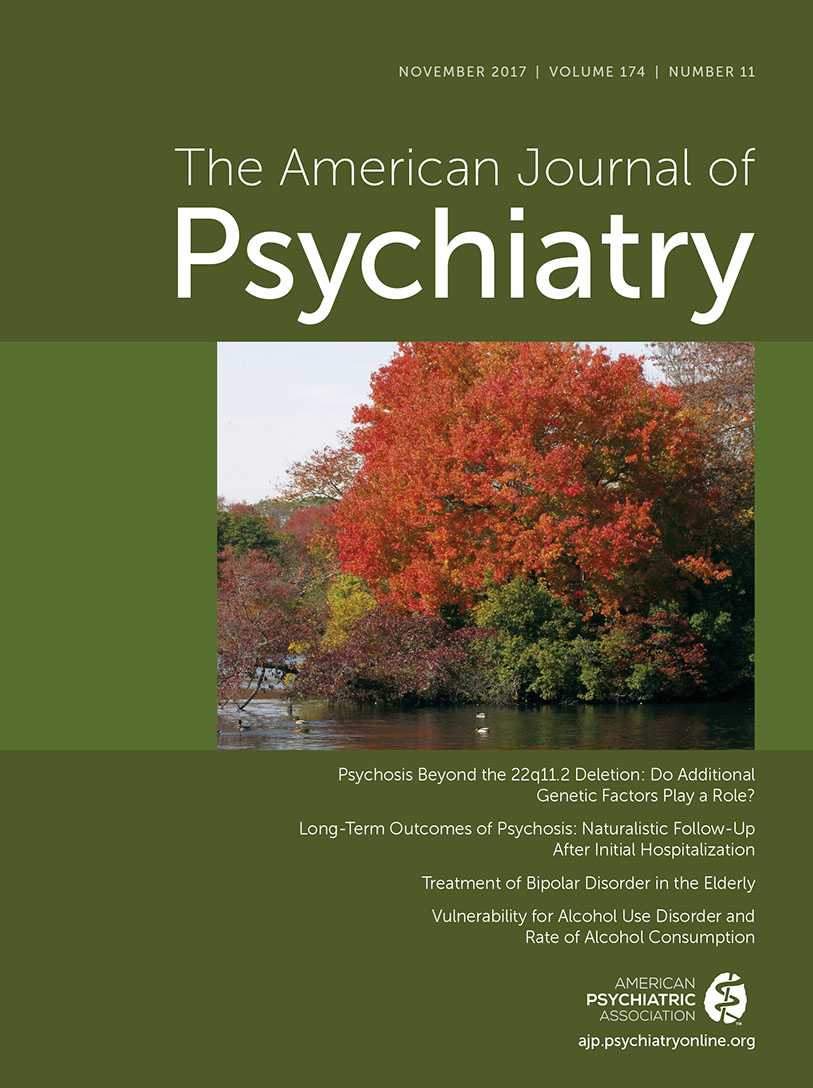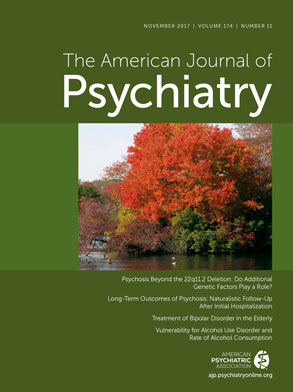Understanding the life course of mental illnesses and more specifically psychosis is challenging, especially in the United States. Our multiple health care systems may not track individuals over time, and individuals may move from one provider or system to another or not access care. As a result, we have very limited information on the long-term outcomes of individuals with psychosis. Two early studies in the literature, the Iowa 500 study (
1) and the Vermont Study (
2), reached very different conclusions. The Iowa 500 study signaled long-term decline and poor outcome; the Vermont study offered images of older individuals in recovery.
The Suffolk County Mental Health Project now provides 20-year outcomes based on a population-based sampling frame attempting to follow all patients identified at first hospitalization regardless of subsequent treatment participation. The term “landmark study” may be tossed around lightly, but the Suffolk County study was a landmark study when Evelyn Bromet and her colleagues began their work (
3). The study reflects both their vision and that of the National Institute of Mental Health, which has funded the research from then until the present. The two articles in this issue mark another epidemiological landmark (
4,
5).
Suffolk County is in the eastern half of Long Island in New York State. In 1990 there were 1.3 million people living there, and about 90% were Caucasian. There are no large cities in the county, but a number of towns have population densities that represent urban living. The study was designed to capture all individuals with psychosis experiencing a first psychiatric hospitalization; 628 patients were enrolled between 1989 and 1995. They were, on average, in their late twenties, over 50% male, and predominantly Caucasian. Previous assessment waves provide information for diagnosis and its predictors at 2 and 10 years (
6,
7). Patients initially diagnosed as having schizophrenia spectrum or bipolar disorder tended to maintain those diagnoses. But by 10 years after admission, the percentage of patients with a schizophrenia spectrum diagnosis had risen from 29% to 50%. These diagnoses are used for the 20-year analyses on the grounds that diagnosis may be uncertain initially and that clinical course is important in establishing diagnoses. However, a major strength of the Suffolk County study is identification of individuals at first hospitalization. Results based on 6-month diagnosis are referred to but not presented by Kotov et al. (
4). To fully capitalize on the prognostic value of this first-hospitalization population, long-term outcome based on initial diagnoses should be presented in detail.
After index hospitalization participants were seen at 6, 24, and 48 months and 10 and 20 years; 68% of the surviving cohort of 549 were seen at year 20, and almost 13% had died. Both articles used sophisticated statistical methods that capitalize on all data available over the life of the study and examined trajectories rather than cross-sectional outcome at 20 years. Both started with the 6-month evaluation, excluding baseline, when patients were symptomatic, which compromised social functioning and restricted the variability of clinical outcome measures.
Kotov and colleagues (
4) present trajectories for the Global Assessment of Functioning (GAF) (
8) and clinical symptoms, comparing three diagnostic groups: schizophrenia spectrum, mood disorder with psychosis, and other psychoses. Schizophrenia spectrum represented 47% of the year-20 cohort. And the clinical course of these patients showed a dramatic decline over 20 years. GAF scores for these patients were at a mean of 53 when they were first assessed and had moved lower to 44 after 10 years, and by 20 years the average score was 36. A score of 40 is defined as “serious impairment in functioning.” Trajectories of individuals diagnosed with mood disorders with psychosis also showed decline, but a less dramatic one—the final average score was about 55.
Kotov and colleagues also present (in Figure S1 in the data supplement) use of antipsychotics, mood stabilizers, and antidepressants. Use of antipsychotics is consistently high (80%) among those with a schizophrenia spectrum disorder and declines from 63% at month 6 to 32% at year 20 among those with a mood disorder. Use of antidepressants was comparable in the three groups (about 40% at year 20), and mood stabilizers were used more frequently among those with mood disorders (about 40%). These data do not allow for causal inference. But antipsychotic use is correlated with clinical outcomes differentially depending on diagnosis. For the schizophrenia spectrum, antipsychotic use is associated with worse outcomes for specific symptoms, except for reality testing, where use is associated with improved outcome.
Velthorst and colleagues (
5) identified four social functioning trajectories ranging from profoundly impaired to preserved and examined the association of these trajectories to diagnosis, premorbid social adjustment, and other outcomes at 20 years. They included three diagnostic groups: schizophrenia spectrum, bipolar with psychosis, and depression with psychosis. In addition, a never-psychotic control group was recruited at the 20-year point and matched on key demographic characteristics and neighborhood. The more frequent trajectories were severely (N=181) and moderately (N=148) impaired. Less frequent were profoundly impaired (N=74) and preserved (N=82). These trajectories are consistent over time, even before the onset of psychosis. Schizophrenia spectrum diagnoses are overrepresented in the profoundly and severely impaired groups. Bipolar disorder fared as well as the never-psychotic comparison group.
The 20-year outcomes presented are concerning, especially for those with a schizophrenia spectrum diagnosis after 10 years. Further, the fact that almost 13% of the patients initially assessed in the early nineties have died provides additional concern. No further information is provided about these individuals, but they are as large a group as those who have a profoundly impaired social functioning trajectory. Both articles stress the fact that there is variability in outcome and large standard deviations (e.g., Figure 2 in the article by Velthorst et al. [
5]) emphasize that.
There is a great deal more that we should learn from this two-decade study. There is variability in the outcomes presented, and examination of those whose outcomes run counter to the averages would be valuable. Examination of those who died would be informative, particularly identification of suicides and when in the course of the 20 years the deaths occurred. Information about physical health trajectories over time would be valuable. The two articles used different diagnostic classifications; the article on clinical outcomes (
4) combined bipolar disorder and depression, and the analysis of social functioning trajectories (
5) distinguished these two groups. There are differences between the groups in social functioning; are there also subtle if not statistically significant differences in clinical course? Adjustments for age and antipsychotic medication made virtually no differences in clinical outcomes, but further exploration of treatment and its time course would be instructive. Measures of cognitive functioning were collected during the first 2 years of the study. Do any of these influence long-term outcome? The never-psychotic control group (N=262) that was recruited at the time of the 20-year follow-up is only briefly mentioned and described by Velthorst and colleagues (
5). The social functioning of the control group appears to be at about the same level as the preserved group. But further comparison with the 373 psychosis patients assessed at year 20 would be valuable. The Suffolk County Mental Health Project is a resource that should be more fully utilized.
The authors call for improvement in care delivery models to improve outcomes, and their data on social functioning trajectories as well as clinical symptom and GAF outcomes support that need. Critical questions about treatment for first-episode psychosis remain. The RAISE-ETP study compared NAVIGATE, a coordinated specialty care intervention for first-episode psychosis, to community care (
9). There was significantly more improvement in quality of life over 2 years of treatment (measured with a full version of the Quality of Life Scale [
10], from which the social functioning measure of Velthorst et al. [
5] was derived) but primarily for those with a less than 74-week duration of untreated psychosis. Whether coordinated specialty care implemented broadly will influence longer-term outcome remains to be determined.

